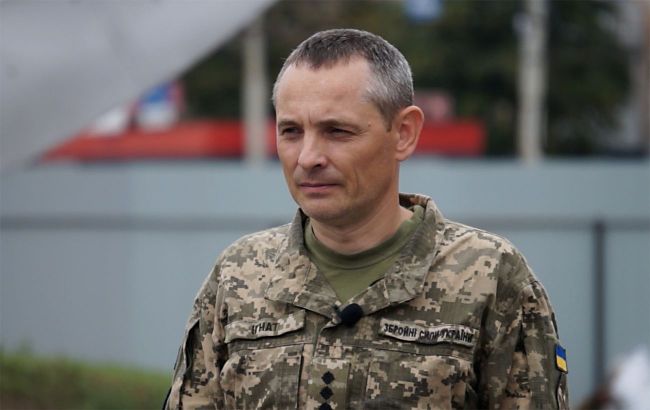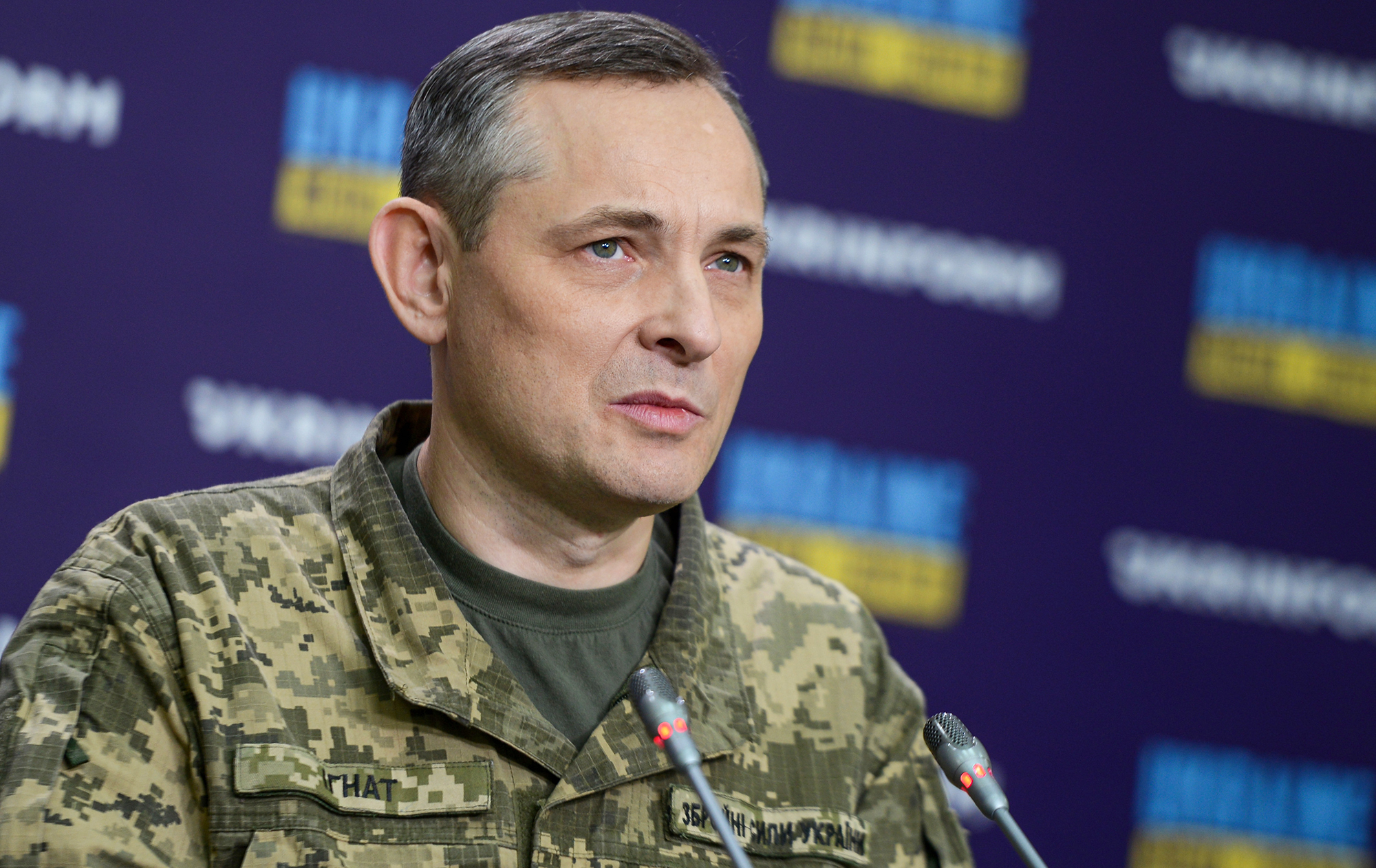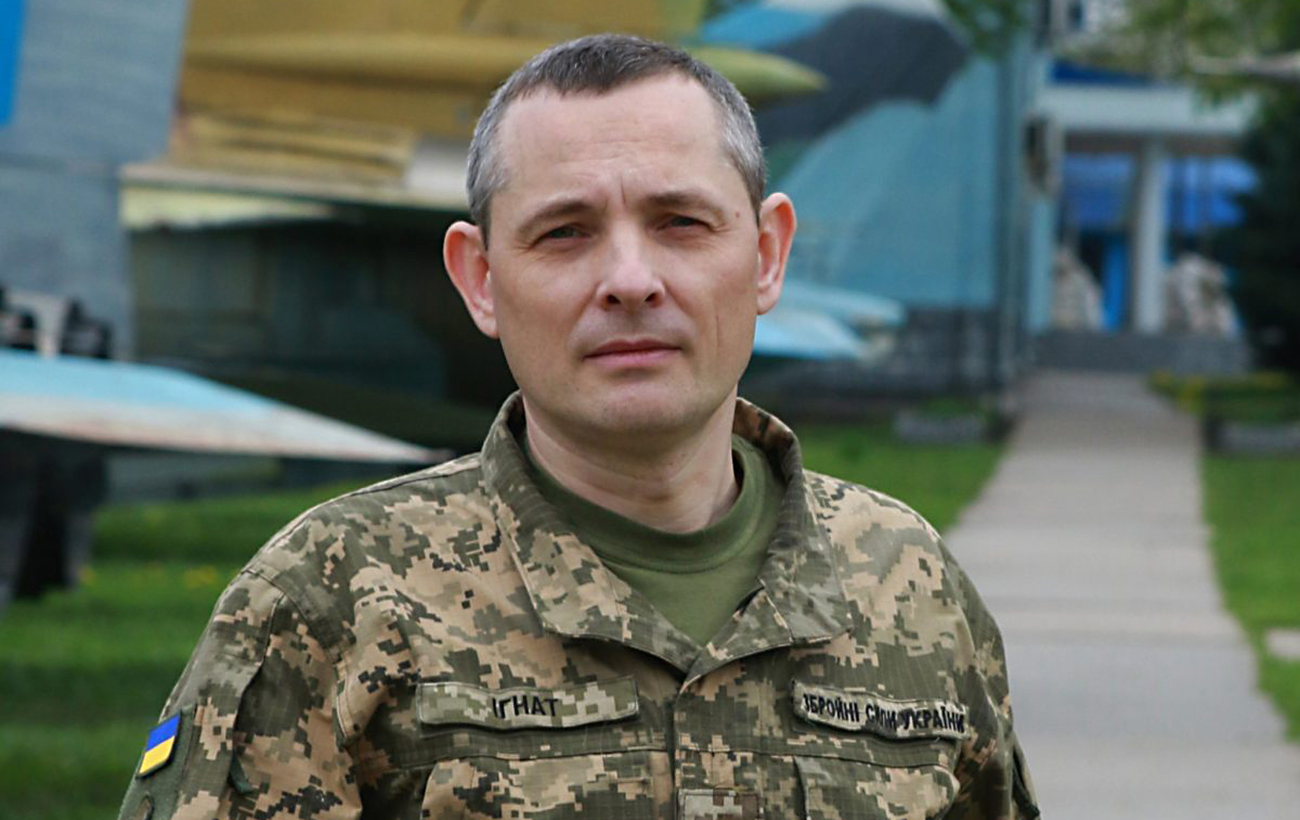Russia not just amassing missiles but rebuilding strategic stockpile - Ukrainian Air Force representative
 Yurii Ihnat, spokesperson for the Air Force Command of the Ukrainian Armed Forces (photo: suspilne media)
Yurii Ihnat, spokesperson for the Air Force Command of the Ukrainian Armed Forces (photo: suspilne media)
In an interview with RBC-Ukraine, Colonel Yurii Ihnat, spokesperson for the Air Force Command of the Ukrainian Armed Forces, spoke about possible Russian attacks on Ukraine's energy system, concerns about MiG-31K missile carriers, the peculiarities of the Ukrainian air defense system and Russians' attacks.
Ukraine is in anxious anticipation of a repeat of last year's events when the Russians wanted to "extinguish" our energy grid. At this time a year ago, we were already on the verge of a blackout. Military intelligence and other specialized agencies warn that the aggressor has not given up on achieving this goal, but now it seems to be preparing more thoroughly to implement its plan. The enemy has stepped up the production of high-precision missiles and launched an assembly line of Iranian Shahed missiles.
The latter is likely to become the main element of Russian terrorist attacks on the energy system, suggests Yurii Ihnat, spokesperson for the Air Force Command of the Armed Forces of Ukraine. In an interview with RBC-Ukraine, he spoke about what the enemy may be preparing for us this winter and how the tactics and methods of shelling the Russians are changing.
- Could you describe the latest, most massive attack of the Shaheds on Kyiv? There was information that about 66 kamikaze drones were destroyed in the capital and Kyiv region. Are there any other peculiarities in this attack, besides the fact that it is a record number launched on Kyiv?
- There are no peculiarities as such. The Shaheds came from two directions - from the Kursk region, they went through our northern regions, and they also tried to destroy them on the way. Others were moving from Primorsko-Akhtarsk - there were also several groups there, and they initially maneuvered through the southern regions to approach Kyiv at about the same time as the northern group.
The enemy has already used this tactic in the Khmelnytskyi region, attacking the airfield in Starokostiantyniv with both missiles and drones. This is a programmable route and flight time, the enemy understands at what point the drones will fly from the south to Kyiv, and another group will fly from the north to Kyiv. This is a stable tactic for the enemy. More than 66 Shaheds were flying to Kyiv at the time, and they tried to destroy them on the way. Up to a dozen drones were destroyed in the area of responsibility of the South and East air commands.
- Was this the first time the Russians used black-painted Shaheds?
- Not quite so. We cannot say that. We saw a photo of a black Shahed. I saw it personally, as you did, on the Internet. We concluded that it was painted, or a composite material, such as carbon fiber, was additionally used, which can also be black. There is no confirmation that there were many such Shaheds, but there is already such a case. According to my information, there was only one such Shahed at the time, which may have been experimentally released to see how our air defense would react to it. But it was also destroyed, as were the ones that flew in the following days - it is already clear that the occupiers began to paint them with spray paint.
- During that attack, were there any hits in Kyiv or the region?
- Hits of debris. At night, any downing can look bright. Therefore, if the warhead or other elements of the downed drone fell, they could cause some localized explosions. If I'm not mistaken, there was no information about critical damage or casualties.
- So the air defense and mobile fire teams in Kyiv and the region were virtually 100% effective during that attack?
- That's right, on the outskirts of the capital and in the capital itself.
 Photo: GettyImages
Photo: GettyImages
The result of their work depends on the density of air defense, especially mobile fire groups. After all, if they work with large-caliber machine guns, their area of effect is a maximum of one and a half to two kilometers. If they are armed with man-portable air defense systems, this provides a longer range. After the attack, the commander of the Air Force, Lieutenant General Mykola Oleshchuk, noted the work of the mobile groups, as they accounted for about 40% of the downed aircraft that night. Their work is important to us because it allows us to save anti-aircraft-guided missiles, which are very valuable to us.
- What is the overall effectiveness of mobile fire groups in other regions of Ukraine?
- It varies. It all depends on the circumstances, on the directions the enemy is attacking, on the effectiveness of command and control and warning, on whether they have the means to move quickly and mobilize, and on the experience of the fighters in the groups. These can be operators of anti-aircraft guns (ZU-23-2), large-caliber machine guns, machine guns, and an operator of man-portable air defense systems (Ihla, Stinger).
If the enemy has sent the Shaheds to a place where it is possible to see them clearly, then the groups have a better chance of working efficiently. But Ukraine has a different terrain - there are plains, forests, and hills. That's why the enemy uses the terrain to push their Shaheds as far as possible. Imagine you are on a road, and there is a forest belt to the left and right - this already complicates your work. Or you're in a low-lying area, and there are hills all around - this also creates obstacles to detect the drone in time to work on it. We are talking about seconds here. You need to be in the right place at the right time to get results.
- These mobile fire teams are on duty in all regions, right?
- Of course, they are. Mobile fire groups are not only part of the Air Force, but also of all the Defense Forces - the Border Guards, the National Guard, and the Army. This is a necessary step to shoot down the maximum number of Shahed before they fly up to larger air defense systems - NASAMS, Iris-T, etc. It is important to destroy them with small arms so that we have a stockpile of anti-aircraft missiles to repel a cruise missile attack and deter Russian aircraft.
- Can we assume that this attack on Kyiv was a test by the Russians of new tactics on how to further attack the Ukrainian energy system?
- They strike with a large number of UAVs, and you have to understand that each drone always has its target. Each of them was aimed at something - some military, infrastructure, or strategic object. There are plenty of such objects in Kyiv that they would like to hit. Secondly, they forced us to spend a certain amount of anti-aircraft-guided missiles to repel this attack. This is a second, indirect goal - the depletion of our air defense.
After all, for example, 40% of the mobile fire groups were shot down by anti-aircraft guns and small arms, some were shot down by Gepard and Crotale, and some could have been shot down by a fighter jet. But for the rest, we had to use powerful air defense systems. The enemy is also well aware of this, so the Russians also have a goal of exhaustion. Therefore, it is necessary to increase the number of means that will be rational for shooting down UAVs. Today, the Gepard is the best in this regard in terms of cost-effectiveness. But it also has a limited range - 4.5 kilometers to shoot down with ground-based projectiles. Therefore, we need more of them - both Gepards and their analogs.
- When I talk to people, I hear them say: it's strange, we are already in December, and the Russians have not started shelling the energy sector yet, while last year at this time we were more without power than with it. Is it possible that the Russians will not attack our energy system at all this winter?
- They will act following their strategic plan. Their main idea is to destroy Ukraine. And believe me, they will want to do us as much damage as possible. Nothing has changed in their policy. If they haven't started such strikes yet, they can do it any other day. But they don't have as many means as they did last year.
- We recently published material with data from the Main Directorate of Intelligence. From the figures we were given on the stockpile at the end of October, it follows that the Russians now have either as many or even more missiles than they had in October last year. They now have more than 870 missiles, including ballistic missiles.
- During the six months of attacks on the energy sector (from September 9 to March 12), we shot down 750 cruise missiles, while about 1,100 were launched. Plus, they kept 30% in their stockpile. That is, they had approximately only 1600 cruise missiles as of September last year. Now they have both types of Kinzhal and Iskanders, as well as X-22s, Kalibr, Kh-101s, and Kh-555s, totaling 870. So, according to my calculations, they have fewer missiles now.
By the way, during that period of attacks on the energy sector, the same number of drones were launched - more than 1,000 and up to 750 were destroyed. Now the situation is different for the Russians - they can both produce and receive more drones from Iran.
- Is that why you think that during the attacks, the emphasis will be on the Shaheds?
- It is already happening, just count the last three months.
- But at the same time, do you assume that the strikes could be combined, i.e., missiles could be fired along with the Shaheds?
- Of course. They are not just amassing missiles, they are rebuilding their strategic stockpile. After all, most of the missiles we are talking about are also carriers of tactical nuclear weapons. They need this critical stockpile to threaten NATO countries and other enemies.
- When the Shaheds are flying, can they be seen on our radar systems, like a missile flight?
- Of course, they are visible. Our duty service, like other duty services, has access to the Virage Tablet system, which shows the air situation on a monitor. Accordingly, we use this system and other closed sources of information to maintain our Air Force telegram channel, where we inform about missile and drone threats without too much detail. Why is this so? Sometimes, like cruise missiles, Shaheds can hide from our radar for a while, so there is no need to inform the enemy about it.
- Are Shaheds a more difficult target to shoot down than cruise missiles? As far as I understand, they are relatively slow, which makes it difficult to shoot them down from our fighters.
- They fly at a speed of 100-200 kilometers per hour along the route set by the operators. They change these routes every time. They simply fly too low and too slow for a fighter jet to effectively intercept them. Yes, they are more difficult for fighters to shoot down. But as for other means, we cannot say that they are more difficult to hit than cruise missiles. Both targets are complex. Both targets are designed to overcome air defense systems. It all depends on the circumstances, on the conditions, on the terrain.
- Sometimes we see that after the alarm is activated and telegram channels, in particular those of the Air Force, report a missile threat, some missiles "cease to exist". Or the telegram channels indicate that it was not a missile, but a fake target or the work of enemy electronic warfare. Why do the Russians do this in the first place? Why are they launching these fake targets, as I understand it, with the help of radio signals?
- Obviously, to achieve some kind of goal. And what goal could that be? It's misleading. Sometimes this target can be the operation of multiple launch rocket systems. They also give a "pickup" on radar, meaning that a radar station can pick up a signal from Smerch, Grad, Uragan, etc., and then it seems like a missile is flying.
 Photo: armyinform
Photo: armyinform
In addition, the enemy's electronic warfare equipment can emit a radio magnetic pulse, which our radar stations will also perceive as a target. It may appear on the monitors showing the air situation for a while and then disappear. We don't know right away whether it's an electronic warfare system or not, but we have to inform people very quickly that there is a missile threat.
In the end, the target may cease to exist, even if it is a real missile, such as a Kh-59, but it may simply fall in the field before reaching the target.
- Can they send out such electronic signals to spy on the location of our air defense systems?
- How?
- For example, when our radars detect the launch of an enemy target, more and more air defense systems are activated and ready to repel the threat. When they are activated, they also emit a signal. Accordingly, the Russians record this for themselves, for example, with the help of an A-50 aircraft, simulating a threat.
- In general, the theory is correct. But when combat operations are underway, when the Russians are firing real missiles, they can see our radar stations and air defense systems also emit a signal. We also have appropriate countermeasures for such cases. And the A-50 cannot scan the whole of Ukraine either.
- Everyone talks about these long alerts because of the MiG-31K. Is there any solution at all to prevent these several-hour flights of MiGs from paralyzing the whole of Ukraine, and the capital in particular?
- This question is not really up to us. The Air Force will continue to inform about the threat via MiGs and provide this information to the operational officer on duty at the State Emergency Service in Kyiv, who launches the warning system. At the same time, the government has instructed the relevant ministries and agencies to develop a solution to respond to MiG-31K flights. I cannot say what this solution will be. We will continue to inform you about the threat.
- Does our air defense system know when this MiG takes off with or without missiles on the suspension?
- Our Western partners in NATO try to inform us as quickly and as fully as possible about a particular MiG-31K flight. Plus, there is our intelligence. But we don't always have information on whether it's flying with or without a missile, whether it's just a flight, a combat flight, or just a training flight.
- If you have information that it is without a missile, then the alarm does not go off?
- If there is accurate information that the MiG-31K does not pose a threat, then, of course, no alarm will be raised.
- What airfields are these MiGs taking off from now?
- There are three main ones: Savasleika, Mozdok, and Akhtubinsk.
- And why do the Shaheds fly to Starokostiantyniv so often?
- Because there is an airfield where our tactical aircraft are based. Accordingly, this is of interest to the Russians. We have dozens of operational airfields, but for some reason, this one is of the greatest interest to the enemy.
- Mayor Andriy Sadovyi predicted that in 2024 the Lviv International Airport could resume operations in the city. In addition, he said, the launch of another airport, Boryspil, is being considered. There have been other statements regarding the reopening of airports. Is this issue being considered?
- This issue is not my competence, so I cannot comment on it.
- The President said that the most difficult situation with air defense is in the border and frontline regions of Ukraine. What are the difficulties?
- Of course, there are problems not so much in the work of air defense, but in the number of people. Of course, we don't have enough means to cover the whole of Ukraine. In addition, there are certain risks in the frontline regions because our air defense systems are a potential target for enemy artillery, MLRS, CABs, etc.
- And what about the air defense of the Odesa region?
- Western systems are used there, among other things. And they work quite effectively. However, sometimes the enemy strikes with Onyx or Kh-22 in the Odesa and Mykolaiv regions.
- Is the third Patriot battery from Germany already on combat duty in Ukraine?
- Our people are currently undergoing training on Patriot in Germany. Germany has announced that it will provide us with a third system. However, the Air Force does not announce when this will happen or if it has already happened, so as not to give the enemy too much information.
- At what stage is the training of our F-16 pilots now?
- At the stage of flights with instructors, in Denmark. But there are other sites, including in the United States and the United Kingdom.
- How many of these fighters have our partners promised to give us in total?
- We should not be tied to any specifics, promises, or prospects; our goal is to completely renew the fleet of Soviet aircraft: airplanes, helicopters, and UAVs. We have an ultimate goal of about 150 combat aircraft. Plus, of course, training and combat aircraft.

